Nursing Paper on Sciatica and Liver Dysfunction
VerifiedAdded on 2023/01/20
|10
|3465
|35
AI Summary
This nursing paper discusses the causes, symptoms, and treatment options for sciatica and liver dysfunction. It explores the impact of herniated discs on sciatica and the effects of liver dysfunction on drug metabolism. The paper also examines the use of metoclopramide as an anti-emetic medication and compares it to ondansetron. Overall, it provides valuable insights for nursing professionals.
Contribute Materials
Your contribution can guide someone’s learning journey. Share your
documents today.

NURSING PAPER 1
Nursing Paper
Student’s Name
Institutional Affiliation
Professor’s Name
City
Date
Nursing Paper
Student’s Name
Institutional Affiliation
Professor’s Name
City
Date
Secure Best Marks with AI Grader
Need help grading? Try our AI Grader for instant feedback on your assignments.
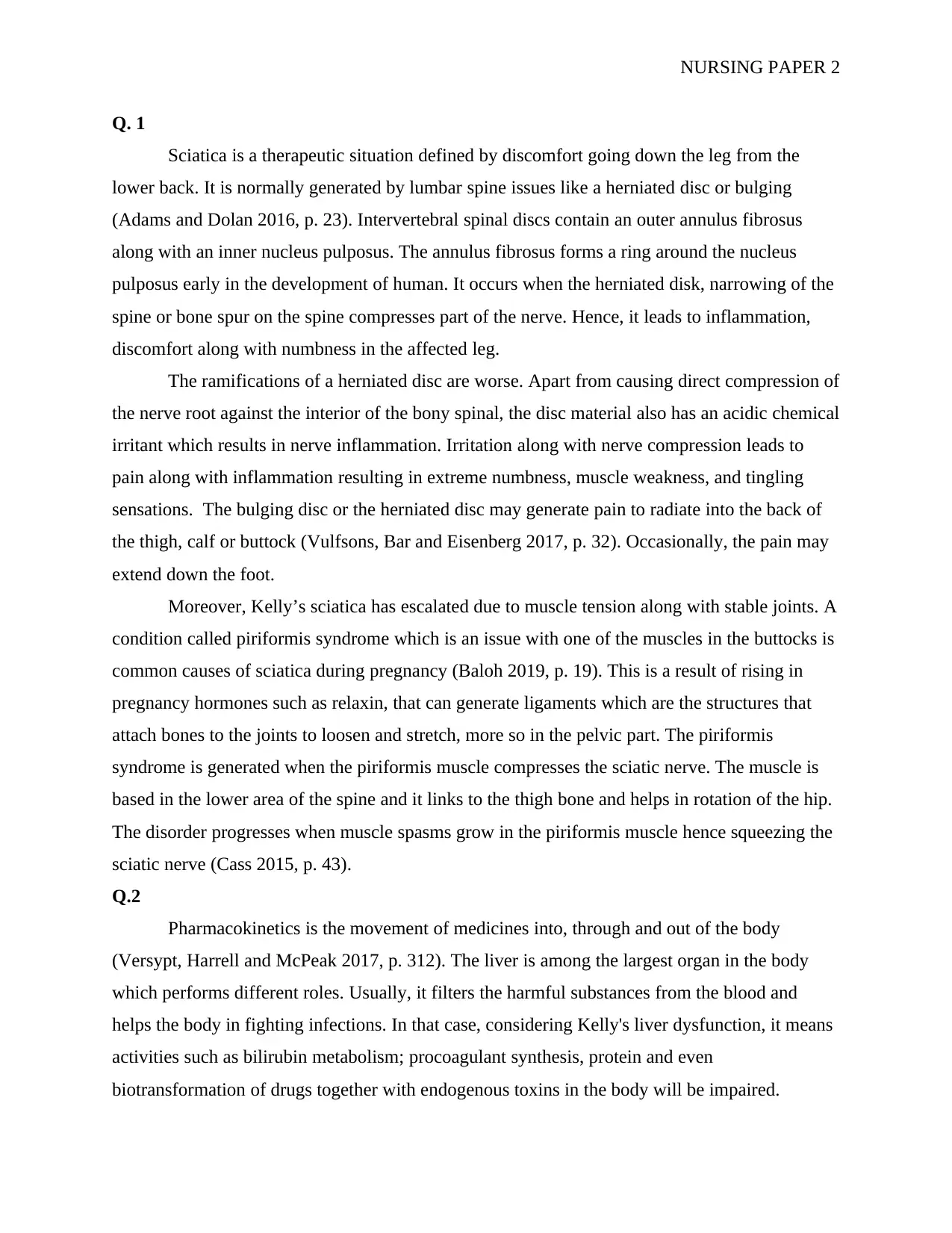
NURSING PAPER 2
Q. 1
Sciatica is a therapeutic situation defined by discomfort going down the leg from the
lower back. It is normally generated by lumbar spine issues like a herniated disc or bulging
(Adams and Dolan 2016, p. 23). Intervertebral spinal discs contain an outer annulus fibrosus
along with an inner nucleus pulposus. The annulus fibrosus forms a ring around the nucleus
pulposus early in the development of human. It occurs when the herniated disk, narrowing of the
spine or bone spur on the spine compresses part of the nerve. Hence, it leads to inflammation,
discomfort along with numbness in the affected leg.
The ramifications of a herniated disc are worse. Apart from causing direct compression of
the nerve root against the interior of the bony spinal, the disc material also has an acidic chemical
irritant which results in nerve inflammation. Irritation along with nerve compression leads to
pain along with inflammation resulting in extreme numbness, muscle weakness, and tingling
sensations. The bulging disc or the herniated disc may generate pain to radiate into the back of
the thigh, calf or buttock (Vulfsons, Bar and Eisenberg 2017, p. 32). Occasionally, the pain may
extend down the foot.
Moreover, Kelly’s sciatica has escalated due to muscle tension along with stable joints. A
condition called piriformis syndrome which is an issue with one of the muscles in the buttocks is
common causes of sciatica during pregnancy (Baloh 2019, p. 19). This is a result of rising in
pregnancy hormones such as relaxin, that can generate ligaments which are the structures that
attach bones to the joints to loosen and stretch, more so in the pelvic part. The piriformis
syndrome is generated when the piriformis muscle compresses the sciatic nerve. The muscle is
based in the lower area of the spine and it links to the thigh bone and helps in rotation of the hip.
The disorder progresses when muscle spasms grow in the piriformis muscle hence squeezing the
sciatic nerve (Cass 2015, p. 43).
Q.2
Pharmacokinetics is the movement of medicines into, through and out of the body
(Versypt, Harrell and McPeak 2017, p. 312). The liver is among the largest organ in the body
which performs different roles. Usually, it filters the harmful substances from the blood and
helps the body in fighting infections. In that case, considering Kelly's liver dysfunction, it means
activities such as bilirubin metabolism; procoagulant synthesis, protein and even
biotransformation of drugs together with endogenous toxins in the body will be impaired.
Q. 1
Sciatica is a therapeutic situation defined by discomfort going down the leg from the
lower back. It is normally generated by lumbar spine issues like a herniated disc or bulging
(Adams and Dolan 2016, p. 23). Intervertebral spinal discs contain an outer annulus fibrosus
along with an inner nucleus pulposus. The annulus fibrosus forms a ring around the nucleus
pulposus early in the development of human. It occurs when the herniated disk, narrowing of the
spine or bone spur on the spine compresses part of the nerve. Hence, it leads to inflammation,
discomfort along with numbness in the affected leg.
The ramifications of a herniated disc are worse. Apart from causing direct compression of
the nerve root against the interior of the bony spinal, the disc material also has an acidic chemical
irritant which results in nerve inflammation. Irritation along with nerve compression leads to
pain along with inflammation resulting in extreme numbness, muscle weakness, and tingling
sensations. The bulging disc or the herniated disc may generate pain to radiate into the back of
the thigh, calf or buttock (Vulfsons, Bar and Eisenberg 2017, p. 32). Occasionally, the pain may
extend down the foot.
Moreover, Kelly’s sciatica has escalated due to muscle tension along with stable joints. A
condition called piriformis syndrome which is an issue with one of the muscles in the buttocks is
common causes of sciatica during pregnancy (Baloh 2019, p. 19). This is a result of rising in
pregnancy hormones such as relaxin, that can generate ligaments which are the structures that
attach bones to the joints to loosen and stretch, more so in the pelvic part. The piriformis
syndrome is generated when the piriformis muscle compresses the sciatic nerve. The muscle is
based in the lower area of the spine and it links to the thigh bone and helps in rotation of the hip.
The disorder progresses when muscle spasms grow in the piriformis muscle hence squeezing the
sciatic nerve (Cass 2015, p. 43).
Q.2
Pharmacokinetics is the movement of medicines into, through and out of the body
(Versypt, Harrell and McPeak 2017, p. 312). The liver is among the largest organ in the body
which performs different roles. Usually, it filters the harmful substances from the blood and
helps the body in fighting infections. In that case, considering Kelly's liver dysfunction, it means
activities such as bilirubin metabolism; procoagulant synthesis, protein and even
biotransformation of drugs together with endogenous toxins in the body will be impaired.
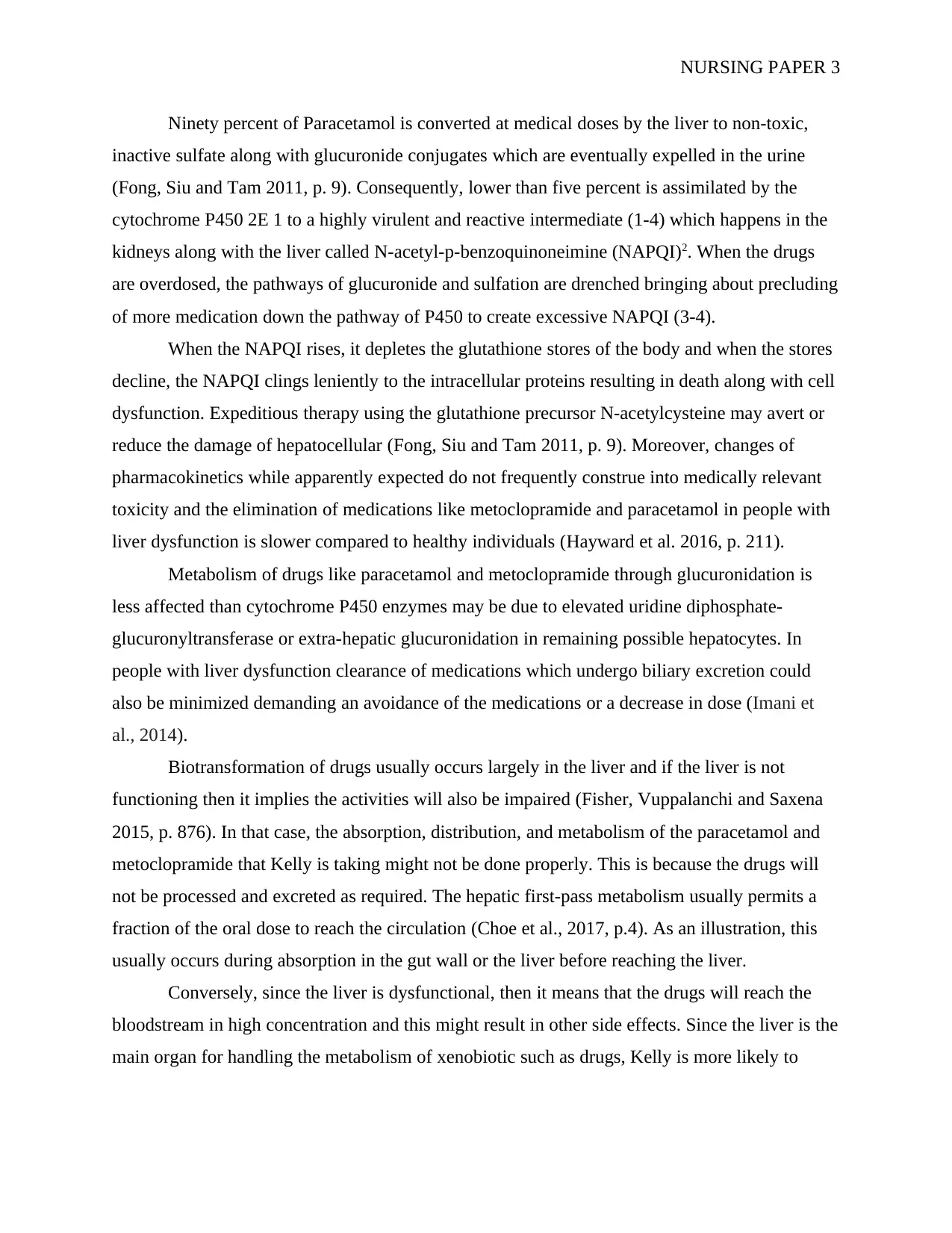
NURSING PAPER 3
Ninety percent of Paracetamol is converted at medical doses by the liver to non-toxic,
inactive sulfate along with glucuronide conjugates which are eventually expelled in the urine
(Fong, Siu and Tam 2011, p. 9). Consequently, lower than five percent is assimilated by the
cytochrome P450 2E 1 to a highly virulent and reactive intermediate (1-4) which happens in the
kidneys along with the liver called N-acetyl-p-benzoquinoneimine (NAPQI)2. When the drugs
are overdosed, the pathways of glucuronide and sulfation are drenched bringing about precluding
of more medication down the pathway of P450 to create excessive NAPQI (3-4).
When the NAPQI rises, it depletes the glutathione stores of the body and when the stores
decline, the NAPQI clings leniently to the intracellular proteins resulting in death along with cell
dysfunction. Expeditious therapy using the glutathione precursor N-acetylcysteine may avert or
reduce the damage of hepatocellular (Fong, Siu and Tam 2011, p. 9). Moreover, changes of
pharmacokinetics while apparently expected do not frequently construe into medically relevant
toxicity and the elimination of medications like metoclopramide and paracetamol in people with
liver dysfunction is slower compared to healthy individuals (Hayward et al. 2016, p. 211).
Metabolism of drugs like paracetamol and metoclopramide through glucuronidation is
less affected than cytochrome P450 enzymes may be due to elevated uridine diphosphate-
glucuronyltransferase or extra-hepatic glucuronidation in remaining possible hepatocytes. In
people with liver dysfunction clearance of medications which undergo biliary excretion could
also be minimized demanding an avoidance of the medications or a decrease in dose (Imani et
al., 2014).
Biotransformation of drugs usually occurs largely in the liver and if the liver is not
functioning then it implies the activities will also be impaired (Fisher, Vuppalanchi and Saxena
2015, p. 876). In that case, the absorption, distribution, and metabolism of the paracetamol and
metoclopramide that Kelly is taking might not be done properly. This is because the drugs will
not be processed and excreted as required. The hepatic first-pass metabolism usually permits a
fraction of the oral dose to reach the circulation (Choe et al., 2017, p.4). As an illustration, this
usually occurs during absorption in the gut wall or the liver before reaching the liver.
Conversely, since the liver is dysfunctional, then it means that the drugs will reach the
bloodstream in high concentration and this might result in other side effects. Since the liver is the
main organ for handling the metabolism of xenobiotic such as drugs, Kelly is more likely to
Ninety percent of Paracetamol is converted at medical doses by the liver to non-toxic,
inactive sulfate along with glucuronide conjugates which are eventually expelled in the urine
(Fong, Siu and Tam 2011, p. 9). Consequently, lower than five percent is assimilated by the
cytochrome P450 2E 1 to a highly virulent and reactive intermediate (1-4) which happens in the
kidneys along with the liver called N-acetyl-p-benzoquinoneimine (NAPQI)2. When the drugs
are overdosed, the pathways of glucuronide and sulfation are drenched bringing about precluding
of more medication down the pathway of P450 to create excessive NAPQI (3-4).
When the NAPQI rises, it depletes the glutathione stores of the body and when the stores
decline, the NAPQI clings leniently to the intracellular proteins resulting in death along with cell
dysfunction. Expeditious therapy using the glutathione precursor N-acetylcysteine may avert or
reduce the damage of hepatocellular (Fong, Siu and Tam 2011, p. 9). Moreover, changes of
pharmacokinetics while apparently expected do not frequently construe into medically relevant
toxicity and the elimination of medications like metoclopramide and paracetamol in people with
liver dysfunction is slower compared to healthy individuals (Hayward et al. 2016, p. 211).
Metabolism of drugs like paracetamol and metoclopramide through glucuronidation is
less affected than cytochrome P450 enzymes may be due to elevated uridine diphosphate-
glucuronyltransferase or extra-hepatic glucuronidation in remaining possible hepatocytes. In
people with liver dysfunction clearance of medications which undergo biliary excretion could
also be minimized demanding an avoidance of the medications or a decrease in dose (Imani et
al., 2014).
Biotransformation of drugs usually occurs largely in the liver and if the liver is not
functioning then it implies the activities will also be impaired (Fisher, Vuppalanchi and Saxena
2015, p. 876). In that case, the absorption, distribution, and metabolism of the paracetamol and
metoclopramide that Kelly is taking might not be done properly. This is because the drugs will
not be processed and excreted as required. The hepatic first-pass metabolism usually permits a
fraction of the oral dose to reach the circulation (Choe et al., 2017, p.4). As an illustration, this
usually occurs during absorption in the gut wall or the liver before reaching the liver.
Conversely, since the liver is dysfunctional, then it means that the drugs will reach the
bloodstream in high concentration and this might result in other side effects. Since the liver is the
main organ for handling the metabolism of xenobiotic such as drugs, Kelly is more likely to
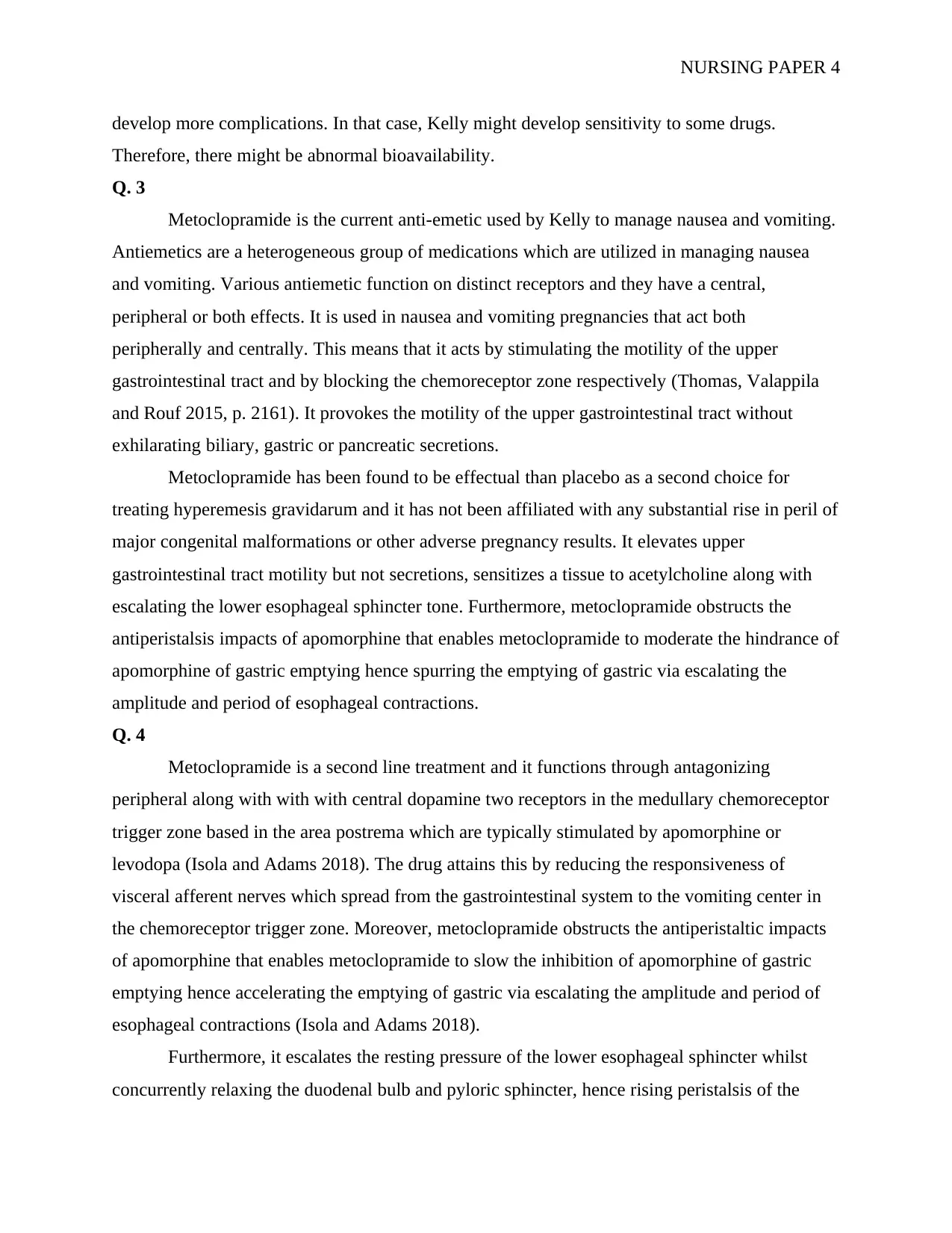
NURSING PAPER 4
develop more complications. In that case, Kelly might develop sensitivity to some drugs.
Therefore, there might be abnormal bioavailability.
Q. 3
Metoclopramide is the current anti-emetic used by Kelly to manage nausea and vomiting.
Antiemetics are a heterogeneous group of medications which are utilized in managing nausea
and vomiting. Various antiemetic function on distinct receptors and they have a central,
peripheral or both effects. It is used in nausea and vomiting pregnancies that act both
peripherally and centrally. This means that it acts by stimulating the motility of the upper
gastrointestinal tract and by blocking the chemoreceptor zone respectively (Thomas, Valappila
and Rouf 2015, p. 2161). It provokes the motility of the upper gastrointestinal tract without
exhilarating biliary, gastric or pancreatic secretions.
Metoclopramide has been found to be effectual than placebo as a second choice for
treating hyperemesis gravidarum and it has not been affiliated with any substantial rise in peril of
major congenital malformations or other adverse pregnancy results. It elevates upper
gastrointestinal tract motility but not secretions, sensitizes a tissue to acetylcholine along with
escalating the lower esophageal sphincter tone. Furthermore, metoclopramide obstructs the
antiperistalsis impacts of apomorphine that enables metoclopramide to moderate the hindrance of
apomorphine of gastric emptying hence spurring the emptying of gastric via escalating the
amplitude and period of esophageal contractions.
Q. 4
Metoclopramide is a second line treatment and it functions through antagonizing
peripheral along with with with central dopamine two receptors in the medullary chemoreceptor
trigger zone based in the area postrema which are typically stimulated by apomorphine or
levodopa (Isola and Adams 2018). The drug attains this by reducing the responsiveness of
visceral afferent nerves which spread from the gastrointestinal system to the vomiting center in
the chemoreceptor trigger zone. Moreover, metoclopramide obstructs the antiperistaltic impacts
of apomorphine that enables metoclopramide to slow the inhibition of apomorphine of gastric
emptying hence accelerating the emptying of gastric via escalating the amplitude and period of
esophageal contractions (Isola and Adams 2018).
Furthermore, it escalates the resting pressure of the lower esophageal sphincter whilst
concurrently relaxing the duodenal bulb and pyloric sphincter, hence rising peristalsis of the
develop more complications. In that case, Kelly might develop sensitivity to some drugs.
Therefore, there might be abnormal bioavailability.
Q. 3
Metoclopramide is the current anti-emetic used by Kelly to manage nausea and vomiting.
Antiemetics are a heterogeneous group of medications which are utilized in managing nausea
and vomiting. Various antiemetic function on distinct receptors and they have a central,
peripheral or both effects. It is used in nausea and vomiting pregnancies that act both
peripherally and centrally. This means that it acts by stimulating the motility of the upper
gastrointestinal tract and by blocking the chemoreceptor zone respectively (Thomas, Valappila
and Rouf 2015, p. 2161). It provokes the motility of the upper gastrointestinal tract without
exhilarating biliary, gastric or pancreatic secretions.
Metoclopramide has been found to be effectual than placebo as a second choice for
treating hyperemesis gravidarum and it has not been affiliated with any substantial rise in peril of
major congenital malformations or other adverse pregnancy results. It elevates upper
gastrointestinal tract motility but not secretions, sensitizes a tissue to acetylcholine along with
escalating the lower esophageal sphincter tone. Furthermore, metoclopramide obstructs the
antiperistalsis impacts of apomorphine that enables metoclopramide to moderate the hindrance of
apomorphine of gastric emptying hence spurring the emptying of gastric via escalating the
amplitude and period of esophageal contractions.
Q. 4
Metoclopramide is a second line treatment and it functions through antagonizing
peripheral along with with with central dopamine two receptors in the medullary chemoreceptor
trigger zone based in the area postrema which are typically stimulated by apomorphine or
levodopa (Isola and Adams 2018). The drug attains this by reducing the responsiveness of
visceral afferent nerves which spread from the gastrointestinal system to the vomiting center in
the chemoreceptor trigger zone. Moreover, metoclopramide obstructs the antiperistaltic impacts
of apomorphine that enables metoclopramide to slow the inhibition of apomorphine of gastric
emptying hence accelerating the emptying of gastric via escalating the amplitude and period of
esophageal contractions (Isola and Adams 2018).
Furthermore, it escalates the resting pressure of the lower esophageal sphincter whilst
concurrently relaxing the duodenal bulb and pyloric sphincter, hence rising peristalsis of the
Secure Best Marks with AI Grader
Need help grading? Try our AI Grader for instant feedback on your assignments.
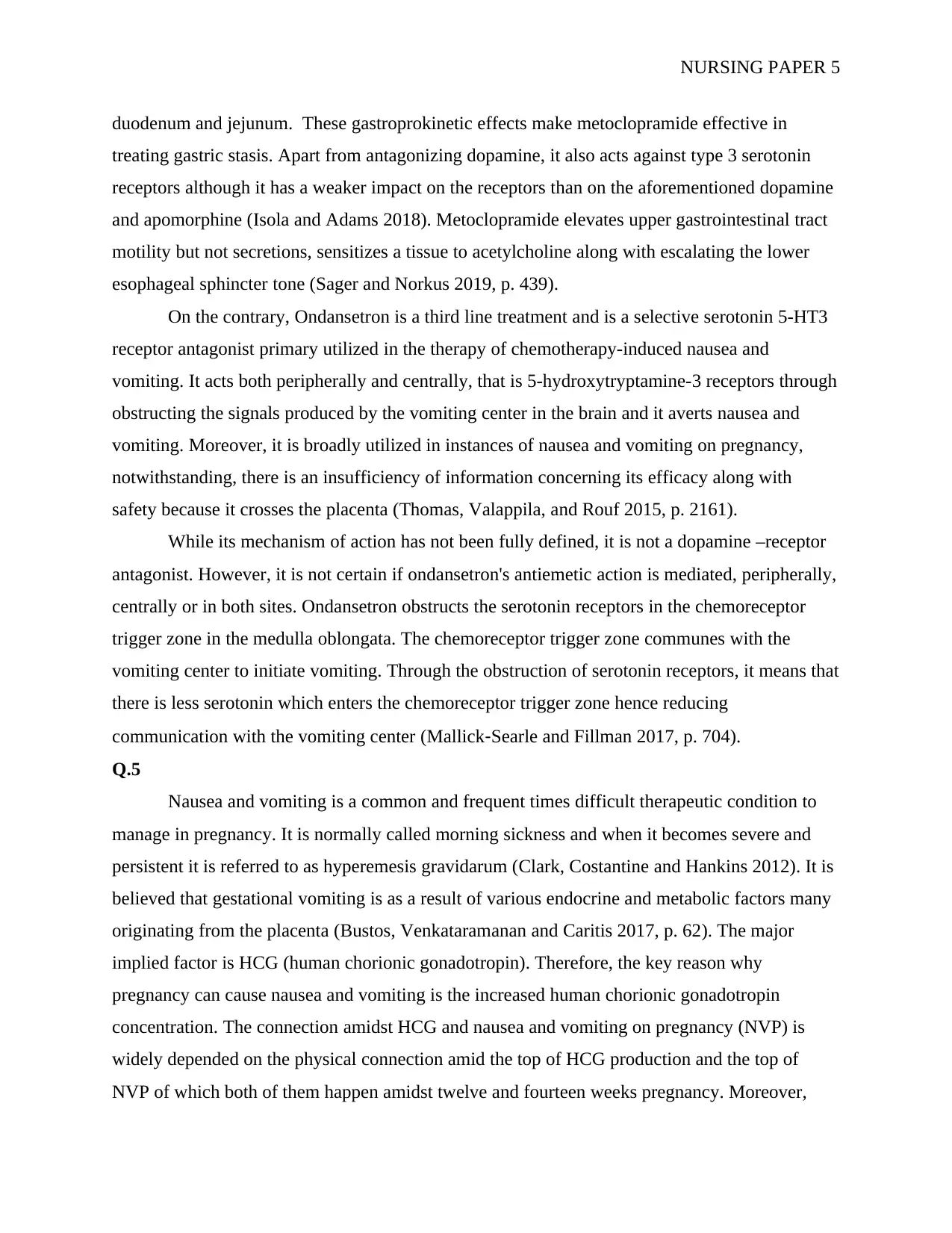
NURSING PAPER 5
duodenum and jejunum. These gastroprokinetic effects make metoclopramide effective in
treating gastric stasis. Apart from antagonizing dopamine, it also acts against type 3 serotonin
receptors although it has a weaker impact on the receptors than on the aforementioned dopamine
and apomorphine (Isola and Adams 2018). Metoclopramide elevates upper gastrointestinal tract
motility but not secretions, sensitizes a tissue to acetylcholine along with escalating the lower
esophageal sphincter tone (Sager and Norkus 2019, p. 439).
On the contrary, Ondansetron is a third line treatment and is a selective serotonin 5-HT3
receptor antagonist primary utilized in the therapy of chemotherapy-induced nausea and
vomiting. It acts both peripherally and centrally, that is 5-hydroxytryptamine-3 receptors through
obstructing the signals produced by the vomiting center in the brain and it averts nausea and
vomiting. Moreover, it is broadly utilized in instances of nausea and vomiting on pregnancy,
notwithstanding, there is an insufficiency of information concerning its efficacy along with
safety because it crosses the placenta (Thomas, Valappila, and Rouf 2015, p. 2161).
While its mechanism of action has not been fully defined, it is not a dopamine –receptor
antagonist. However, it is not certain if ondansetron's antiemetic action is mediated, peripherally,
centrally or in both sites. Ondansetron obstructs the serotonin receptors in the chemoreceptor
trigger zone in the medulla oblongata. The chemoreceptor trigger zone communes with the
vomiting center to initiate vomiting. Through the obstruction of serotonin receptors, it means that
there is less serotonin which enters the chemoreceptor trigger zone hence reducing
communication with the vomiting center (Mallick‐Searle and Fillman 2017, p. 704).
Q.5
Nausea and vomiting is a common and frequent times difficult therapeutic condition to
manage in pregnancy. It is normally called morning sickness and when it becomes severe and
persistent it is referred to as hyperemesis gravidarum (Clark, Costantine and Hankins 2012). It is
believed that gestational vomiting is as a result of various endocrine and metabolic factors many
originating from the placenta (Bustos, Venkataramanan and Caritis 2017, p. 62). The major
implied factor is HCG (human chorionic gonadotropin). Therefore, the key reason why
pregnancy can cause nausea and vomiting is the increased human chorionic gonadotropin
concentration. The connection amidst HCG and nausea and vomiting on pregnancy (NVP) is
widely depended on the physical connection amid the top of HCG production and the top of
NVP of which both of them happen amidst twelve and fourteen weeks pregnancy. Moreover,
duodenum and jejunum. These gastroprokinetic effects make metoclopramide effective in
treating gastric stasis. Apart from antagonizing dopamine, it also acts against type 3 serotonin
receptors although it has a weaker impact on the receptors than on the aforementioned dopamine
and apomorphine (Isola and Adams 2018). Metoclopramide elevates upper gastrointestinal tract
motility but not secretions, sensitizes a tissue to acetylcholine along with escalating the lower
esophageal sphincter tone (Sager and Norkus 2019, p. 439).
On the contrary, Ondansetron is a third line treatment and is a selective serotonin 5-HT3
receptor antagonist primary utilized in the therapy of chemotherapy-induced nausea and
vomiting. It acts both peripherally and centrally, that is 5-hydroxytryptamine-3 receptors through
obstructing the signals produced by the vomiting center in the brain and it averts nausea and
vomiting. Moreover, it is broadly utilized in instances of nausea and vomiting on pregnancy,
notwithstanding, there is an insufficiency of information concerning its efficacy along with
safety because it crosses the placenta (Thomas, Valappila, and Rouf 2015, p. 2161).
While its mechanism of action has not been fully defined, it is not a dopamine –receptor
antagonist. However, it is not certain if ondansetron's antiemetic action is mediated, peripherally,
centrally or in both sites. Ondansetron obstructs the serotonin receptors in the chemoreceptor
trigger zone in the medulla oblongata. The chemoreceptor trigger zone communes with the
vomiting center to initiate vomiting. Through the obstruction of serotonin receptors, it means that
there is less serotonin which enters the chemoreceptor trigger zone hence reducing
communication with the vomiting center (Mallick‐Searle and Fillman 2017, p. 704).
Q.5
Nausea and vomiting is a common and frequent times difficult therapeutic condition to
manage in pregnancy. It is normally called morning sickness and when it becomes severe and
persistent it is referred to as hyperemesis gravidarum (Clark, Costantine and Hankins 2012). It is
believed that gestational vomiting is as a result of various endocrine and metabolic factors many
originating from the placenta (Bustos, Venkataramanan and Caritis 2017, p. 62). The major
implied factor is HCG (human chorionic gonadotropin). Therefore, the key reason why
pregnancy can cause nausea and vomiting is the increased human chorionic gonadotropin
concentration. The connection amidst HCG and nausea and vomiting on pregnancy (NVP) is
widely depended on the physical connection amid the top of HCG production and the top of
NVP of which both of them happen amidst twelve and fourteen weeks pregnancy. Moreover,
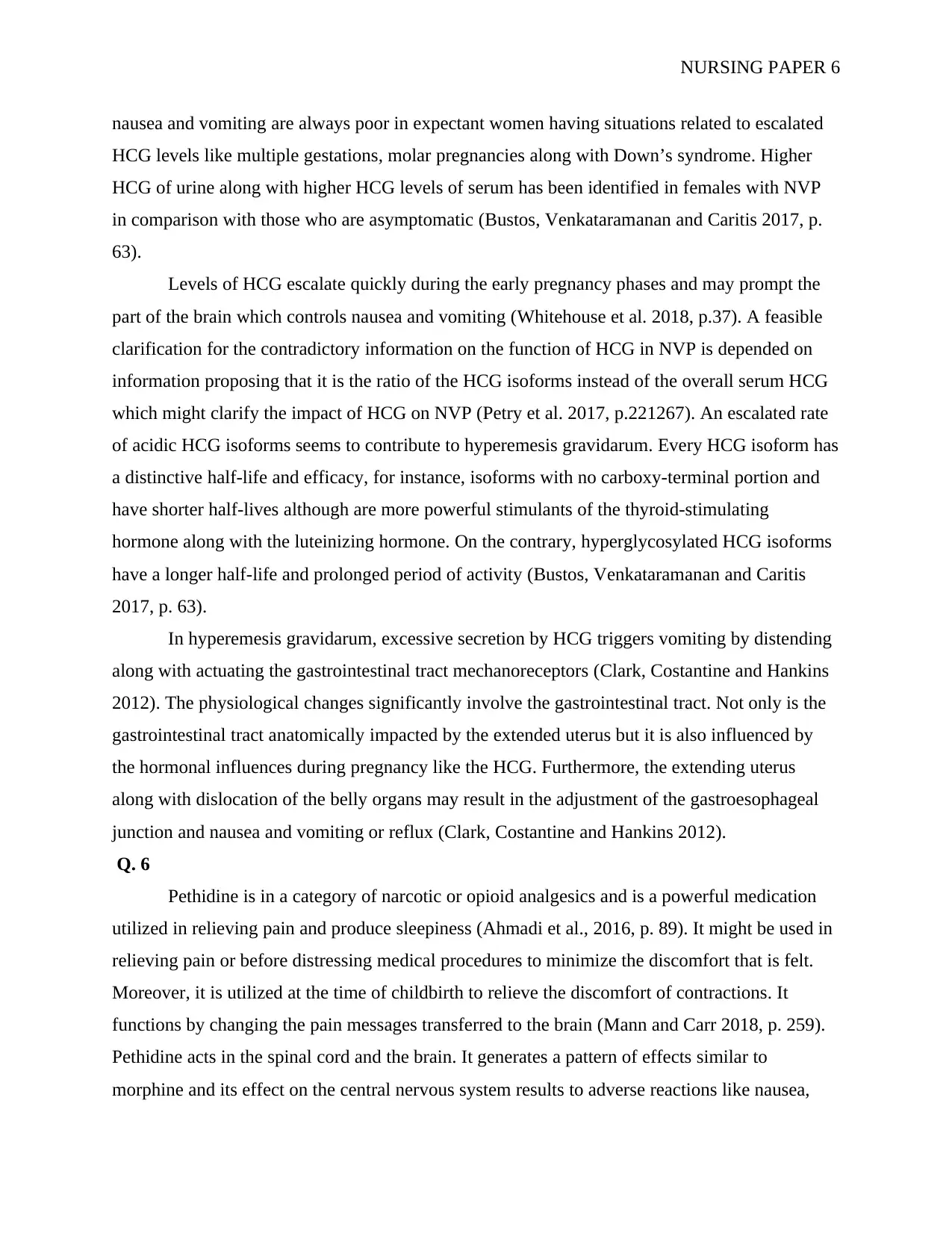
NURSING PAPER 6
nausea and vomiting are always poor in expectant women having situations related to escalated
HCG levels like multiple gestations, molar pregnancies along with Down’s syndrome. Higher
HCG of urine along with higher HCG levels of serum has been identified in females with NVP
in comparison with those who are asymptomatic (Bustos, Venkataramanan and Caritis 2017, p.
63).
Levels of HCG escalate quickly during the early pregnancy phases and may prompt the
part of the brain which controls nausea and vomiting (Whitehouse et al. 2018, p.37). A feasible
clarification for the contradictory information on the function of HCG in NVP is depended on
information proposing that it is the ratio of the HCG isoforms instead of the overall serum HCG
which might clarify the impact of HCG on NVP (Petry et al. 2017, p.221267). An escalated rate
of acidic HCG isoforms seems to contribute to hyperemesis gravidarum. Every HCG isoform has
a distinctive half-life and efficacy, for instance, isoforms with no carboxy-terminal portion and
have shorter half-lives although are more powerful stimulants of the thyroid-stimulating
hormone along with the luteinizing hormone. On the contrary, hyperglycosylated HCG isoforms
have a longer half-life and prolonged period of activity (Bustos, Venkataramanan and Caritis
2017, p. 63).
In hyperemesis gravidarum, excessive secretion by HCG triggers vomiting by distending
along with actuating the gastrointestinal tract mechanoreceptors (Clark, Costantine and Hankins
2012). The physiological changes significantly involve the gastrointestinal tract. Not only is the
gastrointestinal tract anatomically impacted by the extended uterus but it is also influenced by
the hormonal influences during pregnancy like the HCG. Furthermore, the extending uterus
along with dislocation of the belly organs may result in the adjustment of the gastroesophageal
junction and nausea and vomiting or reflux (Clark, Costantine and Hankins 2012).
Q. 6
Pethidine is in a category of narcotic or opioid analgesics and is a powerful medication
utilized in relieving pain and produce sleepiness (Ahmadi et al., 2016, p. 89). It might be used in
relieving pain or before distressing medical procedures to minimize the discomfort that is felt.
Moreover, it is utilized at the time of childbirth to relieve the discomfort of contractions. It
functions by changing the pain messages transferred to the brain (Mann and Carr 2018, p. 259).
Pethidine acts in the spinal cord and the brain. It generates a pattern of effects similar to
morphine and its effect on the central nervous system results to adverse reactions like nausea,
nausea and vomiting are always poor in expectant women having situations related to escalated
HCG levels like multiple gestations, molar pregnancies along with Down’s syndrome. Higher
HCG of urine along with higher HCG levels of serum has been identified in females with NVP
in comparison with those who are asymptomatic (Bustos, Venkataramanan and Caritis 2017, p.
63).
Levels of HCG escalate quickly during the early pregnancy phases and may prompt the
part of the brain which controls nausea and vomiting (Whitehouse et al. 2018, p.37). A feasible
clarification for the contradictory information on the function of HCG in NVP is depended on
information proposing that it is the ratio of the HCG isoforms instead of the overall serum HCG
which might clarify the impact of HCG on NVP (Petry et al. 2017, p.221267). An escalated rate
of acidic HCG isoforms seems to contribute to hyperemesis gravidarum. Every HCG isoform has
a distinctive half-life and efficacy, for instance, isoforms with no carboxy-terminal portion and
have shorter half-lives although are more powerful stimulants of the thyroid-stimulating
hormone along with the luteinizing hormone. On the contrary, hyperglycosylated HCG isoforms
have a longer half-life and prolonged period of activity (Bustos, Venkataramanan and Caritis
2017, p. 63).
In hyperemesis gravidarum, excessive secretion by HCG triggers vomiting by distending
along with actuating the gastrointestinal tract mechanoreceptors (Clark, Costantine and Hankins
2012). The physiological changes significantly involve the gastrointestinal tract. Not only is the
gastrointestinal tract anatomically impacted by the extended uterus but it is also influenced by
the hormonal influences during pregnancy like the HCG. Furthermore, the extending uterus
along with dislocation of the belly organs may result in the adjustment of the gastroesophageal
junction and nausea and vomiting or reflux (Clark, Costantine and Hankins 2012).
Q. 6
Pethidine is in a category of narcotic or opioid analgesics and is a powerful medication
utilized in relieving pain and produce sleepiness (Ahmadi et al., 2016, p. 89). It might be used in
relieving pain or before distressing medical procedures to minimize the discomfort that is felt.
Moreover, it is utilized at the time of childbirth to relieve the discomfort of contractions. It
functions by changing the pain messages transferred to the brain (Mann and Carr 2018, p. 259).
Pethidine acts in the spinal cord and the brain. It generates a pattern of effects similar to
morphine and its effect on the central nervous system results to adverse reactions like nausea,
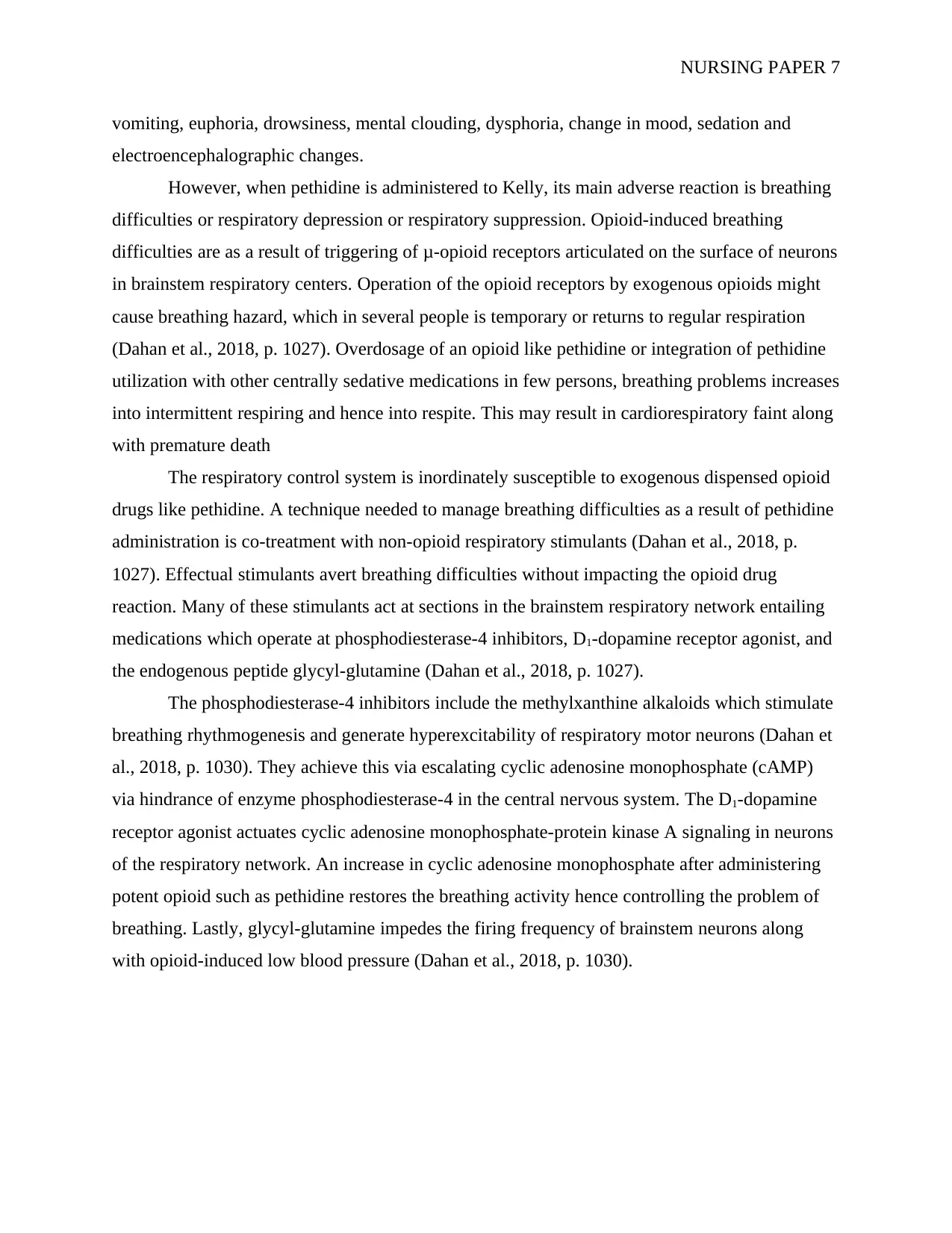
NURSING PAPER 7
vomiting, euphoria, drowsiness, mental clouding, dysphoria, change in mood, sedation and
electroencephalographic changes.
However, when pethidine is administered to Kelly, its main adverse reaction is breathing
difficulties or respiratory depression or respiratory suppression. Opioid-induced breathing
difficulties are as a result of triggering of μ-opioid receptors articulated on the surface of neurons
in brainstem respiratory centers. Operation of the opioid receptors by exogenous opioids might
cause breathing hazard, which in several people is temporary or returns to regular respiration
(Dahan et al., 2018, p. 1027). Overdosage of an opioid like pethidine or integration of pethidine
utilization with other centrally sedative medications in few persons, breathing problems increases
into intermittent respiring and hence into respite. This may result in cardiorespiratory faint along
with premature death
The respiratory control system is inordinately susceptible to exogenous dispensed opioid
drugs like pethidine. A technique needed to manage breathing difficulties as a result of pethidine
administration is co-treatment with non-opioid respiratory stimulants (Dahan et al., 2018, p.
1027). Effectual stimulants avert breathing difficulties without impacting the opioid drug
reaction. Many of these stimulants act at sections in the brainstem respiratory network entailing
medications which operate at phosphodiesterase-4 inhibitors, D1-dopamine receptor agonist, and
the endogenous peptide glycyl-glutamine (Dahan et al., 2018, p. 1027).
The phosphodiesterase-4 inhibitors include the methylxanthine alkaloids which stimulate
breathing rhythmogenesis and generate hyperexcitability of respiratory motor neurons (Dahan et
al., 2018, p. 1030). They achieve this via escalating cyclic adenosine monophosphate (cAMP)
via hindrance of enzyme phosphodiesterase-4 in the central nervous system. The D1-dopamine
receptor agonist actuates cyclic adenosine monophosphate-protein kinase A signaling in neurons
of the respiratory network. An increase in cyclic adenosine monophosphate after administering
potent opioid such as pethidine restores the breathing activity hence controlling the problem of
breathing. Lastly, glycyl-glutamine impedes the firing frequency of brainstem neurons along
with opioid-induced low blood pressure (Dahan et al., 2018, p. 1030).
vomiting, euphoria, drowsiness, mental clouding, dysphoria, change in mood, sedation and
electroencephalographic changes.
However, when pethidine is administered to Kelly, its main adverse reaction is breathing
difficulties or respiratory depression or respiratory suppression. Opioid-induced breathing
difficulties are as a result of triggering of μ-opioid receptors articulated on the surface of neurons
in brainstem respiratory centers. Operation of the opioid receptors by exogenous opioids might
cause breathing hazard, which in several people is temporary or returns to regular respiration
(Dahan et al., 2018, p. 1027). Overdosage of an opioid like pethidine or integration of pethidine
utilization with other centrally sedative medications in few persons, breathing problems increases
into intermittent respiring and hence into respite. This may result in cardiorespiratory faint along
with premature death
The respiratory control system is inordinately susceptible to exogenous dispensed opioid
drugs like pethidine. A technique needed to manage breathing difficulties as a result of pethidine
administration is co-treatment with non-opioid respiratory stimulants (Dahan et al., 2018, p.
1027). Effectual stimulants avert breathing difficulties without impacting the opioid drug
reaction. Many of these stimulants act at sections in the brainstem respiratory network entailing
medications which operate at phosphodiesterase-4 inhibitors, D1-dopamine receptor agonist, and
the endogenous peptide glycyl-glutamine (Dahan et al., 2018, p. 1027).
The phosphodiesterase-4 inhibitors include the methylxanthine alkaloids which stimulate
breathing rhythmogenesis and generate hyperexcitability of respiratory motor neurons (Dahan et
al., 2018, p. 1030). They achieve this via escalating cyclic adenosine monophosphate (cAMP)
via hindrance of enzyme phosphodiesterase-4 in the central nervous system. The D1-dopamine
receptor agonist actuates cyclic adenosine monophosphate-protein kinase A signaling in neurons
of the respiratory network. An increase in cyclic adenosine monophosphate after administering
potent opioid such as pethidine restores the breathing activity hence controlling the problem of
breathing. Lastly, glycyl-glutamine impedes the firing frequency of brainstem neurons along
with opioid-induced low blood pressure (Dahan et al., 2018, p. 1030).
Paraphrase This Document
Need a fresh take? Get an instant paraphrase of this document with our AI Paraphraser
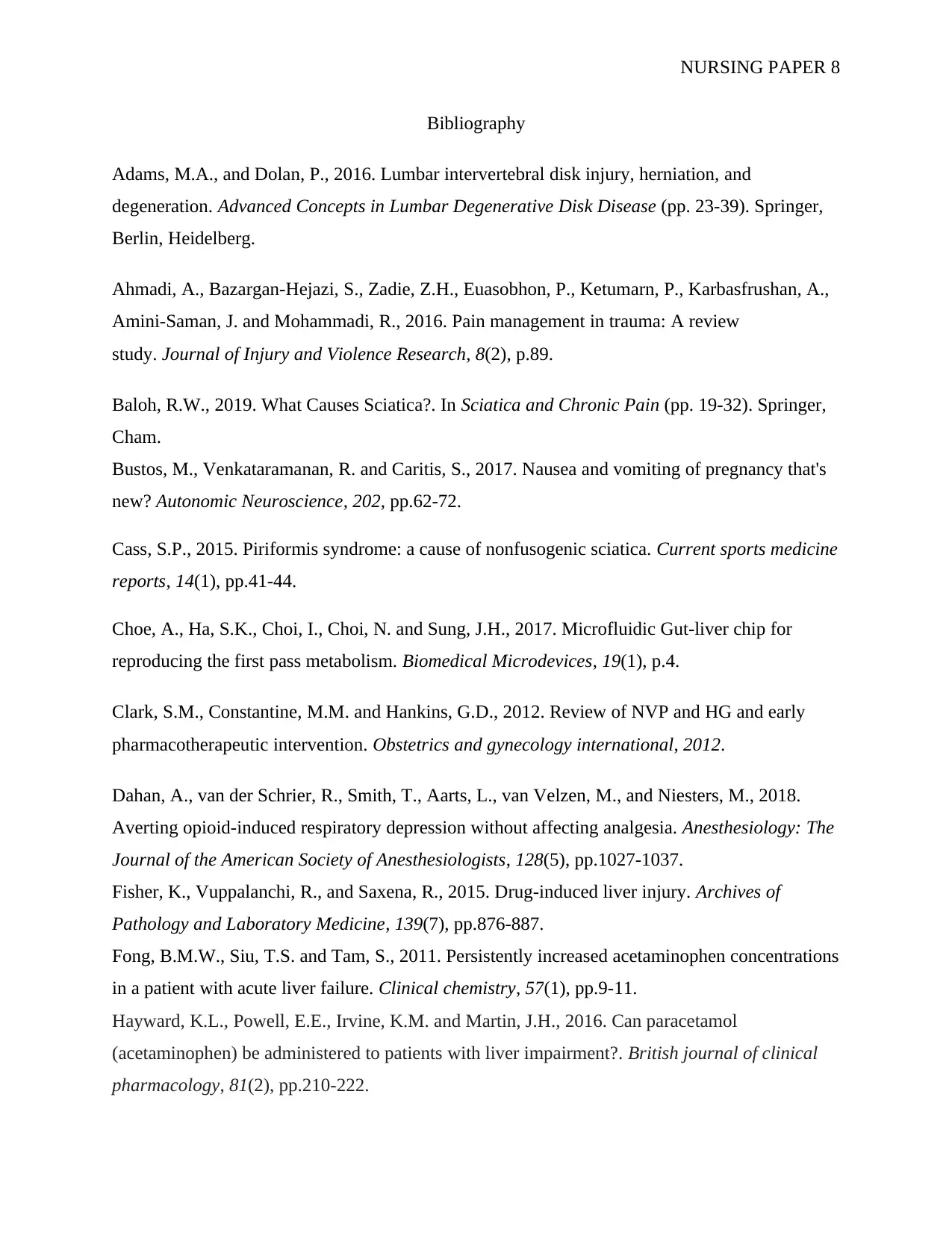
NURSING PAPER 8
Bibliography
Adams, M.A., and Dolan, P., 2016. Lumbar intervertebral disk injury, herniation, and
degeneration. Advanced Concepts in Lumbar Degenerative Disk Disease (pp. 23-39). Springer,
Berlin, Heidelberg.
Ahmadi, A., Bazargan-Hejazi, S., Zadie, Z.H., Euasobhon, P., Ketumarn, P., Karbasfrushan, A.,
Amini-Saman, J. and Mohammadi, R., 2016. Pain management in trauma: A review
study. Journal of Injury and Violence Research, 8(2), p.89.
Baloh, R.W., 2019. What Causes Sciatica?. In Sciatica and Chronic Pain (pp. 19-32). Springer,
Cham.
Bustos, M., Venkataramanan, R. and Caritis, S., 2017. Nausea and vomiting of pregnancy that's
new? Autonomic Neuroscience, 202, pp.62-72.
Cass, S.P., 2015. Piriformis syndrome: a cause of nonfusogenic sciatica. Current sports medicine
reports, 14(1), pp.41-44.
Choe, A., Ha, S.K., Choi, I., Choi, N. and Sung, J.H., 2017. Microfluidic Gut-liver chip for
reproducing the first pass metabolism. Biomedical Microdevices, 19(1), p.4.
Clark, S.M., Constantine, M.M. and Hankins, G.D., 2012. Review of NVP and HG and early
pharmacotherapeutic intervention. Obstetrics and gynecology international, 2012.
Dahan, A., van der Schrier, R., Smith, T., Aarts, L., van Velzen, M., and Niesters, M., 2018.
Averting opioid-induced respiratory depression without affecting analgesia. Anesthesiology: The
Journal of the American Society of Anesthesiologists, 128(5), pp.1027-1037.
Fisher, K., Vuppalanchi, R., and Saxena, R., 2015. Drug-induced liver injury. Archives of
Pathology and Laboratory Medicine, 139(7), pp.876-887.
Fong, B.M.W., Siu, T.S. and Tam, S., 2011. Persistently increased acetaminophen concentrations
in a patient with acute liver failure. Clinical chemistry, 57(1), pp.9-11.
Hayward, K.L., Powell, E.E., Irvine, K.M. and Martin, J.H., 2016. Can paracetamol
(acetaminophen) be administered to patients with liver impairment?. British journal of clinical
pharmacology, 81(2), pp.210-222.
Bibliography
Adams, M.A., and Dolan, P., 2016. Lumbar intervertebral disk injury, herniation, and
degeneration. Advanced Concepts in Lumbar Degenerative Disk Disease (pp. 23-39). Springer,
Berlin, Heidelberg.
Ahmadi, A., Bazargan-Hejazi, S., Zadie, Z.H., Euasobhon, P., Ketumarn, P., Karbasfrushan, A.,
Amini-Saman, J. and Mohammadi, R., 2016. Pain management in trauma: A review
study. Journal of Injury and Violence Research, 8(2), p.89.
Baloh, R.W., 2019. What Causes Sciatica?. In Sciatica and Chronic Pain (pp. 19-32). Springer,
Cham.
Bustos, M., Venkataramanan, R. and Caritis, S., 2017. Nausea and vomiting of pregnancy that's
new? Autonomic Neuroscience, 202, pp.62-72.
Cass, S.P., 2015. Piriformis syndrome: a cause of nonfusogenic sciatica. Current sports medicine
reports, 14(1), pp.41-44.
Choe, A., Ha, S.K., Choi, I., Choi, N. and Sung, J.H., 2017. Microfluidic Gut-liver chip for
reproducing the first pass metabolism. Biomedical Microdevices, 19(1), p.4.
Clark, S.M., Constantine, M.M. and Hankins, G.D., 2012. Review of NVP and HG and early
pharmacotherapeutic intervention. Obstetrics and gynecology international, 2012.
Dahan, A., van der Schrier, R., Smith, T., Aarts, L., van Velzen, M., and Niesters, M., 2018.
Averting opioid-induced respiratory depression without affecting analgesia. Anesthesiology: The
Journal of the American Society of Anesthesiologists, 128(5), pp.1027-1037.
Fisher, K., Vuppalanchi, R., and Saxena, R., 2015. Drug-induced liver injury. Archives of
Pathology and Laboratory Medicine, 139(7), pp.876-887.
Fong, B.M.W., Siu, T.S. and Tam, S., 2011. Persistently increased acetaminophen concentrations
in a patient with acute liver failure. Clinical chemistry, 57(1), pp.9-11.
Hayward, K.L., Powell, E.E., Irvine, K.M. and Martin, J.H., 2016. Can paracetamol
(acetaminophen) be administered to patients with liver impairment?. British journal of clinical
pharmacology, 81(2), pp.210-222.
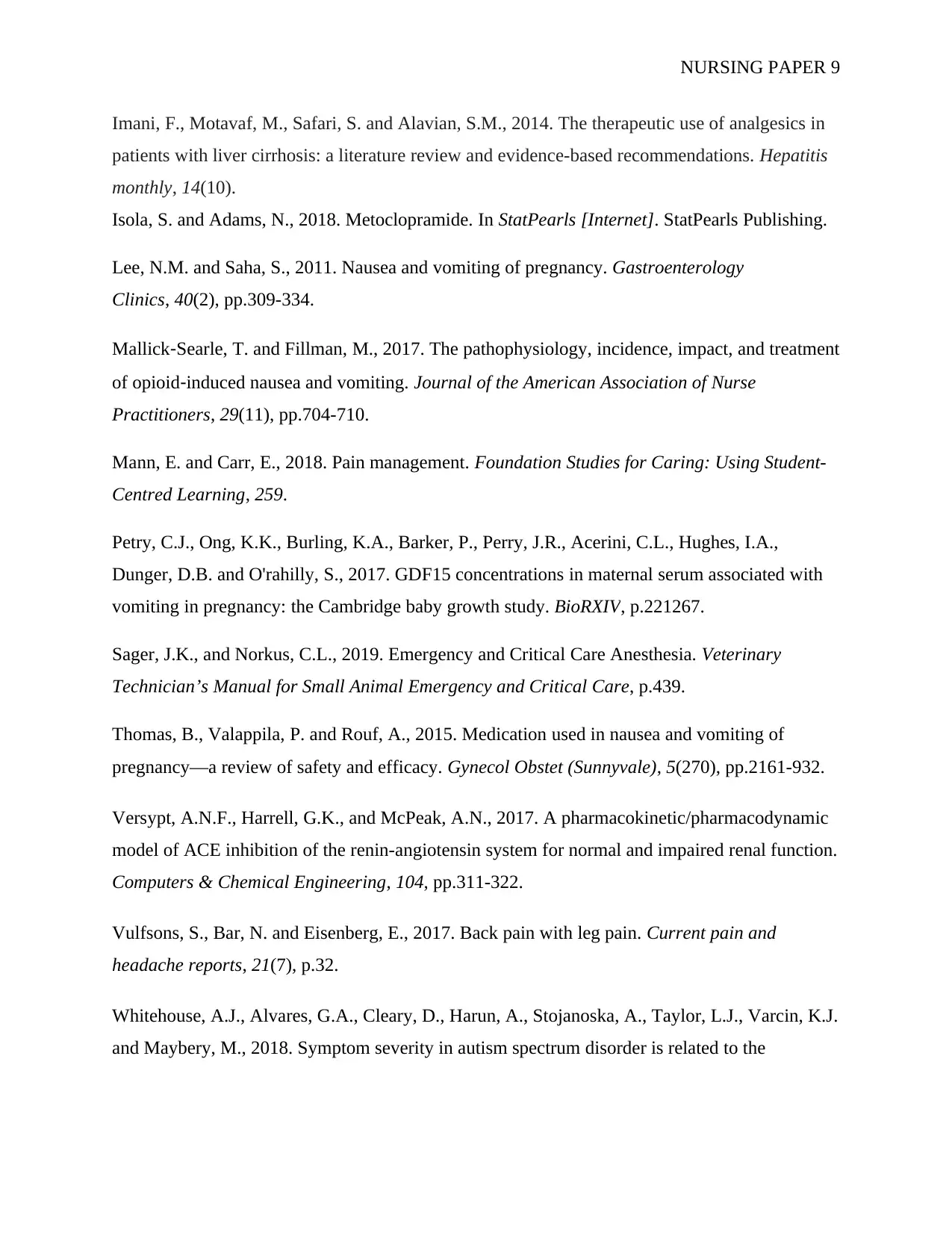
NURSING PAPER 9
Imani, F., Motavaf, M., Safari, S. and Alavian, S.M., 2014. The therapeutic use of analgesics in
patients with liver cirrhosis: a literature review and evidence-based recommendations. Hepatitis
monthly, 14(10).
Isola, S. and Adams, N., 2018. Metoclopramide. In StatPearls [Internet]. StatPearls Publishing.
Lee, N.M. and Saha, S., 2011. Nausea and vomiting of pregnancy. Gastroenterology
Clinics, 40(2), pp.309-334.
Mallick‐Searle, T. and Fillman, M., 2017. The pathophysiology, incidence, impact, and treatment
of opioid‐induced nausea and vomiting. Journal of the American Association of Nurse
Practitioners, 29(11), pp.704-710.
Mann, E. and Carr, E., 2018. Pain management. Foundation Studies for Caring: Using Student-
Centred Learning, 259.
Petry, C.J., Ong, K.K., Burling, K.A., Barker, P., Perry, J.R., Acerini, C.L., Hughes, I.A.,
Dunger, D.B. and O'rahilly, S., 2017. GDF15 concentrations in maternal serum associated with
vomiting in pregnancy: the Cambridge baby growth study. BioRXIV, p.221267.
Sager, J.K., and Norkus, C.L., 2019. Emergency and Critical Care Anesthesia. Veterinary
Technician’s Manual for Small Animal Emergency and Critical Care, p.439.
Thomas, B., Valappila, P. and Rouf, A., 2015. Medication used in nausea and vomiting of
pregnancy—a review of safety and efficacy. Gynecol Obstet (Sunnyvale), 5(270), pp.2161-932.
Versypt, A.N.F., Harrell, G.K., and McPeak, A.N., 2017. A pharmacokinetic/pharmacodynamic
model of ACE inhibition of the renin-angiotensin system for normal and impaired renal function.
Computers & Chemical Engineering, 104, pp.311-322.
Vulfsons, S., Bar, N. and Eisenberg, E., 2017. Back pain with leg pain. Current pain and
headache reports, 21(7), p.32.
Whitehouse, A.J., Alvares, G.A., Cleary, D., Harun, A., Stojanoska, A., Taylor, L.J., Varcin, K.J.
and Maybery, M., 2018. Symptom severity in autism spectrum disorder is related to the
Imani, F., Motavaf, M., Safari, S. and Alavian, S.M., 2014. The therapeutic use of analgesics in
patients with liver cirrhosis: a literature review and evidence-based recommendations. Hepatitis
monthly, 14(10).
Isola, S. and Adams, N., 2018. Metoclopramide. In StatPearls [Internet]. StatPearls Publishing.
Lee, N.M. and Saha, S., 2011. Nausea and vomiting of pregnancy. Gastroenterology
Clinics, 40(2), pp.309-334.
Mallick‐Searle, T. and Fillman, M., 2017. The pathophysiology, incidence, impact, and treatment
of opioid‐induced nausea and vomiting. Journal of the American Association of Nurse
Practitioners, 29(11), pp.704-710.
Mann, E. and Carr, E., 2018. Pain management. Foundation Studies for Caring: Using Student-
Centred Learning, 259.
Petry, C.J., Ong, K.K., Burling, K.A., Barker, P., Perry, J.R., Acerini, C.L., Hughes, I.A.,
Dunger, D.B. and O'rahilly, S., 2017. GDF15 concentrations in maternal serum associated with
vomiting in pregnancy: the Cambridge baby growth study. BioRXIV, p.221267.
Sager, J.K., and Norkus, C.L., 2019. Emergency and Critical Care Anesthesia. Veterinary
Technician’s Manual for Small Animal Emergency and Critical Care, p.439.
Thomas, B., Valappila, P. and Rouf, A., 2015. Medication used in nausea and vomiting of
pregnancy—a review of safety and efficacy. Gynecol Obstet (Sunnyvale), 5(270), pp.2161-932.
Versypt, A.N.F., Harrell, G.K., and McPeak, A.N., 2017. A pharmacokinetic/pharmacodynamic
model of ACE inhibition of the renin-angiotensin system for normal and impaired renal function.
Computers & Chemical Engineering, 104, pp.311-322.
Vulfsons, S., Bar, N. and Eisenberg, E., 2017. Back pain with leg pain. Current pain and
headache reports, 21(7), p.32.
Whitehouse, A.J., Alvares, G.A., Cleary, D., Harun, A., Stojanoska, A., Taylor, L.J., Varcin, K.J.
and Maybery, M., 2018. Symptom severity in autism spectrum disorder is related to the

NURSING PAPER 10
frequency and severity of nausea and vomiting during pregnancy: a retrospective case-control
study. Molecular Autism, 9(1), p.37.
frequency and severity of nausea and vomiting during pregnancy: a retrospective case-control
study. Molecular Autism, 9(1), p.37.
1 out of 10
Your All-in-One AI-Powered Toolkit for Academic Success.
+13062052269
info@desklib.com
Available 24*7 on WhatsApp / Email
![[object Object]](/_next/static/media/star-bottom.7253800d.svg)
Unlock your academic potential
© 2024 | Zucol Services PVT LTD | All rights reserved.



